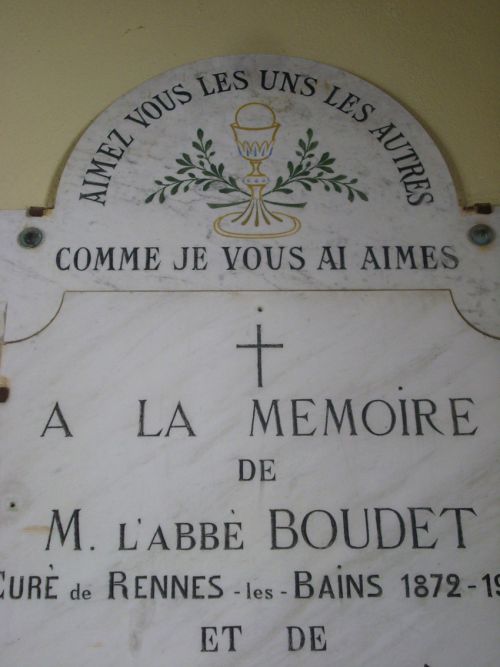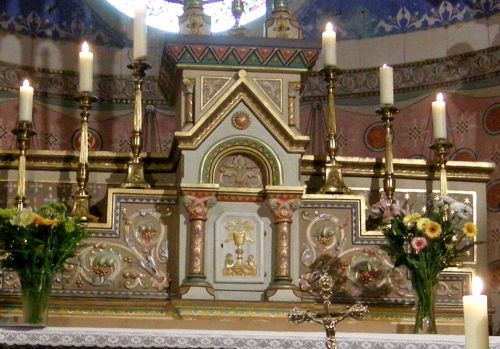HOLY GRAIL part 2 Neo-Cathars
Part 2 of Mary Magdalene and the Holy Grail
In 1202 Robert de Boron wrote a saga called La Queste del Saint Graal. It was one of a series of Grail stories; Estoire du Graal, Merlin, Lancelot, the Queste and Mort Arthur. It’s thought it was actually written by a person or group of people in the Cistercian Order, sometimes known as the “White Friars.” It was a picture of the victorious Christian life. (The Cistercians had eighteen hundred houses in 1200.)
Lancelot was the central figure in the Queste del Saint Graal story. Robert de Boron had already identified Perceval with the search for the Grail as a holy object of desire, but Lancelot had the Christian qualities necessary for anyone who would search for the Holy Grail.
Robert de Boron described the Grail as the actual cup used by Christ at the Last Supper in which Joseph of Arimathea later caught his blood during the crucifixion and then carried this Holy relic to Glastonbury, England. The lance, covered with Jesus’s blood after his side was pierced by Longinus during the crucifixion also entered Grail lore as the Holy Lance.
Robert de Boron was also interested as the Grail as a symbol of a holy search for God, what’s more, a God who reveals himself only to the pure in heart according to Christian definition, hence the heros, Sir Lancelot and Sir Galahad. The Perfect Knight, as seen by an important Christian group in the thirteenth century, was a Christ-like figure.
The other Knights or courtiers were sometimes wicked and very human; they had no chance of seeing God; but they represented the people that the Cistercians wished to convert. The ordinary man was not fit to see God or enjoy his benefits. Mister Ordinary had to be persuaded to adopt a life of purity and self-denial.
De Boron’s story was a “best-seller” of its day, with characters to whom we could all relate, having one adventure after another. With its beautiful ladies, hilltop castles wreathed in mist, woodland glades and cruel knights versus pure knights - it was all romance and drama. Lonely hermits or learned churchmen interpreted it all on a good versus evil scale. The Cistercians explained the adventures that befell the knights in terms of God testing them, for life is a continuous warfare against man’s lower nature. One must always be on guard against the Devil.
Once the knight sees God in his purity he has reached his goal and has nothing left to do then except to die. Thus the Grail is seen as a Quest for Spiritual perfection - in the conventional Christian way of being free from sin.
The eastern legends had now been fully Christianised, and the stories of Arthur in England and in France proliferated. In these legends were plenty of fair ladies and chivalrous knights - but no Mary Magdalene.
Other aspects went underground, as we saw when looking at the Templar Tarot in the previous article - click here.
René d’Anjou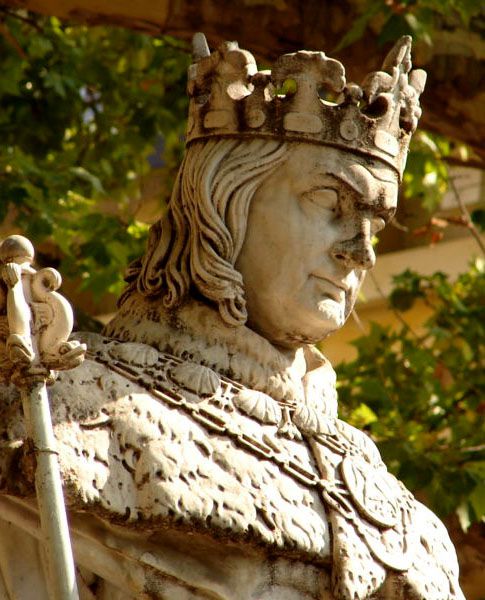 René d'Anjou
René d'Anjou
Born in January 1409, René d’Anjou was a leading character in fifteenth century France. He was involved in esoteric things which included the search for the Holy Grail. He was the King of Naples, the Duke d'Anjou and the Count of Provence; he was known as “Good” because of the many charities he supported. He had ten children by his first wife and 3 illegitimate children, the last one called Madeleine, a French version of Magdalene.
René d’Anjou excavated in Stes Maries de la Mer in 1448, and discovered two skeletons under the early church and declared them to be Mary Salomé and Mary Jacobi, both of them from the time of Mary Magdalene and both of them her friends. Whatever his evidence was for this he didn’t say, but in spite of all the Provençal legends of the time, he never claimed one of them to be Mary Magdalene. This leads me to believe he knew where Mary Magdalene’s remains were, and it was not at Stes. Maries. (Click here to read more.)
In 1454, after the death of his wife, he married again to a lady called Jeanne de Laval and whether she influenced him nobody knows, but he then spent more time on “artistic pursuits.” A picture of their coat of arms included a large cup or goblet, apparently throwing out flames of fire. René treasured this cup, saying it was the one Jesus drank from at the wedding at Cana, but it's believed he carved the cup himelf.. (The one connected with the Grail was at the Last Supper.) The cup was made of porphyry, a form of feldspar with red and white crystals, found in Egypt.
Around the rim is written; He who drinks from this cup shall see God. He who drains it in a single daught will see Mary Magdalene. Could this mean he felt Mary Magdalene was more important than Jesus?
After his marriage in 1457 he wrote an allegorical tale, called Le Cuer d’amours espris - The Heart Pierced by Love. He commissioned beautiful paintings to illustrate the work. At this time of the troubadours the word love had a different meaning; it meant brother love, deep friendship, religious love, and compassion.
In the story the knight, Cuer (heart) accompanied by his Squire, Désir, tries to liberate and win the lady “Doulce Mercy” (sweet compassion) by means of gallant deeds. In one picture Cuer is near a spring or well; the pump handle is mounted on a black marble pillar with a message. This message warns that the water is bitter and there would be terrible consequences if it was spilled. This sounds like a warning such as you find in other legends - don’t go through the forbidden door - don’t open Pandora’s box - don’t drink the water of hidden knowledge.
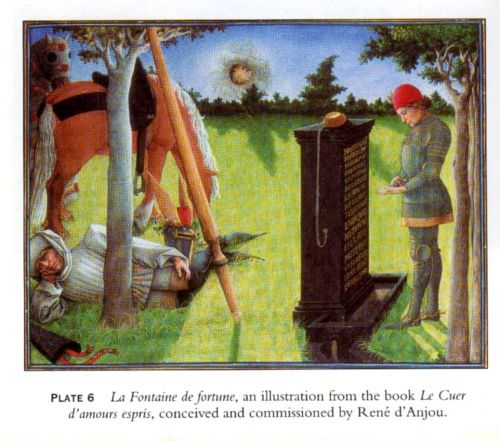
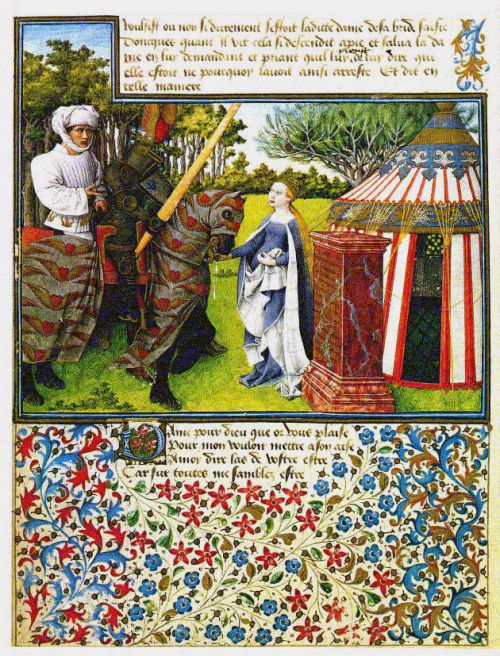
This brings us to the concept of the underground stream of knowledge, beloved by modern freemasons today. Do you remember the poem by Samual Taylor Coleridge, about Alph the sacred river than ran through caverns measureless to man? Then it continued; A savage place! as holy and enchanted as ever beneath a waning moon was haunted by woman wailing for her demon-lover! And from this cavern, with ceaseless turmoil seething, as if this earth in fast thick pants were breathing, a mighty fountain momently was forced . . .
The River Alph really exists, in the Arcadia region of Greece. It disappears underground and is symbolic of the Underground Stream of Knowledge. Once we hear about this, we understand it instinctively. But maybe in René’s time, one was obliged to keep this Knowledge secret, for political reasons.
The Lord and his squire in René’s book were looking for the Holy Grail. The book included sixteen paintings, and the marble plinth holding the pump for the hidden water appears in two of them. It is a tale of unrequited love and the bitter waters are seen rising as a spring and then flowing through the narrative as a river, symbolising the Quest.
You can see more on this site; http://kingrene.guice.org/bklvntro.html René’s masterpiece does not however make a good story today; but it was most popular in medieval times.
The Cup in French churches
I am quite a student of French country churches in the Langedoc where I live, and when I saw images of cups that looked like Grail cups, I was intrigued. Was this evidence of the Christian redefinition of the Grail stories, as outlined above? Were these cups representations of the cup of Joseph of Arimathea that contained Jesus’s blood? It seemed to me the symbolism of a cup - shaped like a womb - could also represent the pregnant Virgin Mary. What was going on?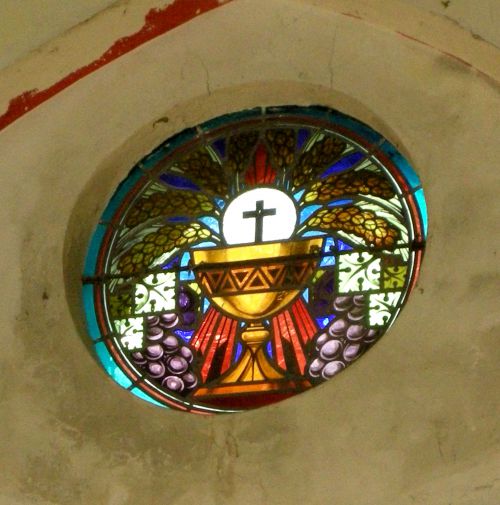
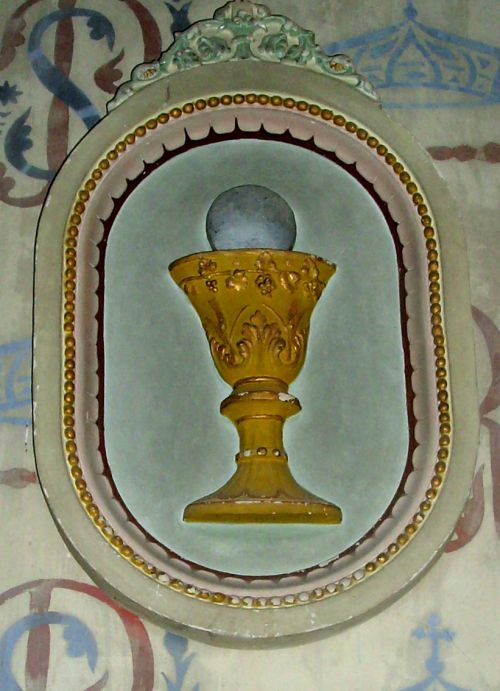
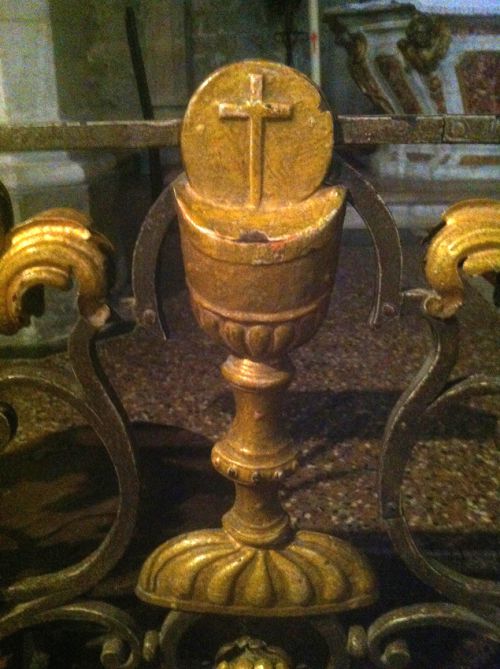
In the chapel of Celles; in Bugarach church; in the church in my home village near Narbonne
The memorial stone in the church porch of Rennes-les-Bains and on the altar at Rennes-le-Château
Then I noticed that all these cups seemed to have something white and circular in them. More research revealed these images did not represent the Holy Grail, but the Eucharist, a solemn and important ceremony enacted in today’s Roman Catholic churches during the mass.
In the Gospel of Saint John, that you will know by now was written by Lazarus, Mary Magdalene’s brother and the closest beloved disciple of Jesus, there is no mention of the Eucharist at the Last Supper, only of Jesus washing the disciple’s feet as a sign that he was there to serve them. However, have a look at John 6, 25 to 59, for some very mystic words. The family in the house at Bethany were doing some deeply spiritual work together.
Matthew, Mark and Luke, but not John, recount a Last Supper story, of Jesus saying the wafer represents his body and the wine represents his blood. The disciples are invited to eat and drink these, in remembrance of Jesus.
Luke mentions the sacrificial lamb that was eaten at Passover and Jesus himself is sometimes known as the sacrificial lamb. The gospels were becoming Romanised, and there were previous religions in Roman times where adherents drank the blood of the God, and where one was baptised in the blood of a bull, or, if bulls were not available, a lamb.
The Roman Church teaches that once consecrated in the Eucharist, the elements cease to be bread and wine and actually become the body and blood of Christ, each of which is accompanied by the other and by Christ's soul and divinity. So those taking the mass actually eat Jesus and drink his blood and merge their souls with his. You cannot “know” Jesus without this ceremony, before which you must be cleansed of your sins. In adolescence, children must take communion and be confirmed in their faith so that they “know” their saviour.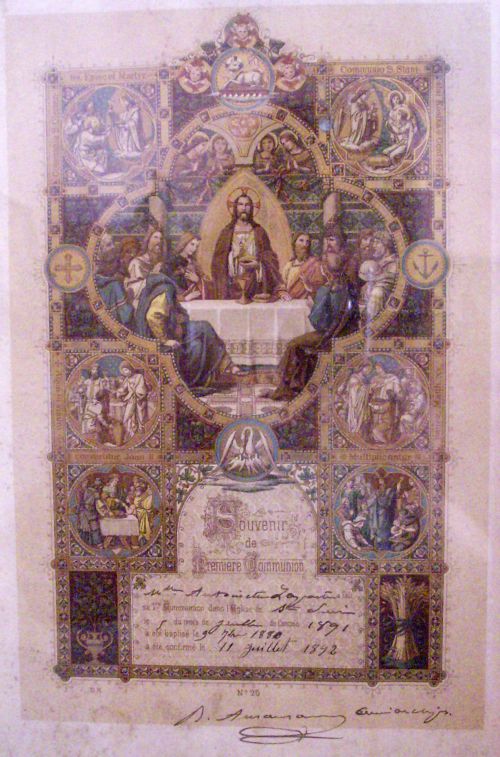
First Communion and Confirmation certifcate from 1892; in the pic, two young ladies with the disciples and Jesus.
No wonder non-Catholics cannot understand this “mystery”! (The Cathars totally rejected the Eucharist, finding the whole idea grossly distasteful.)
Jesus’s blood is contained in a cup. To those of us interested in symbolism, the link between the pregnant womb of a woman and the Holy Grail has been made.
How the Holy Grail came to be linked to the Cathars
In Cathar documented history there is no record whatsoever that it was a “religion of love” or that Mary Magdalene was their priestess at Montségur, nor was the Holy Grail mentioned.
The historical Cathars were the people that suffered for their so-called heresy, between the years 1209 to 1321 in the Languedoc/Ariège region of southern France. The King of France, Louis IX, wanted money to go and fight the Saracens and regain the Holy Land for its “rightful” owners - Roman Christians. To gain funds he commissioned the mercenary soldier, Simon de Montfort, to take the Cathar castles and walled towns in the name of the King. Then the Church stepped in and insisted the “heretics” should be killed or forced to abjure.
It is well-known and documented that the Cathars believed Mary Magdalene and Jesus were married, the only Christian sect ever to do so, and one wonders where this belief came from. Only one solution is logical - that Catharism was based on the original Christianity of Mary Magdalene and Jesus that was taught to the Celtic people by Mary and Jesus themselves when they came to Languedoc.
You can read more by clicking here.
During the Crusade Against the Cathars whole populations were massacred or turned out into the countryside with not even the clothes they stood up in. The last seige, after which the Cathars were burnt alive, took place at the Ariège castle of Montségur in 1244. The final Cathar castle was Queribus, where Olivier de Termes negotiated a surrender in 1257 arguing the Cathar people were not the true enemies of France, but the Saracens were. The Cathars were allowed to leave for Spain but the King got the castle.
In the early 14th century there was a Cathar revival under the Authié brothers, who travelled and converted, but they were captured and executed. The last Cathar to be burnt alive was Bélibaste in the Corbières village of Villerouge-Termenès in 1321.
As Bélibaste walked bravely to his dreadful death he prophesised that “the laurel will bloom again in 700 years.” This was taken to mean that Catharism would return in 700 years, in 2021, and certainly a form of it is taking shape today.
I quote from “The Church of Mary Magdalene, the Sacred Feminine and the Treasure of Rennes-le-Château” by Jean Markale:
The Grail is a recent tradition and not part of the older folklore of the region. It is an intellectual creation from the end of the nineteenth century, born in literary, artistic and “hermetic” circles that were frequented, some maintain, by Bérenger Saunière during his visit to Paris. In full Wagnerian tradition, haunted by the grandiose and mysterious image of the “Holy” Grail, the fin-de siècle intellectuals tried on several occasions to determine the location of the Castle of the Grail. Some recognised it in Montségur, some in Glastonbury. If anyone speaks of the Grail in the Razès, (the area around Rennes-le-Château) it is primarily from the influence of what took place in Montségur.
The author continues to explain that the hunt for the Grail and/or its treasure presumes an initiation, for chance discoveries do not count. Nothing can be found without the “key” that enables the seeker to open the secret door which is on the inside or only leads to a closed palace. To find the key patience is required, and the seeker must study all clues along his path, hidden clues, but hidden by whom?
It’s known the Cathars smuggled a treasure out of Montségur. Historians are agreed that this treasure was probably coins and some religious books, written in Occitan. (At the time it was an offence punishable to death, to possess a Bible or New Testament NOT written in Latin.) Recently the treasure has become mythic and includes the Holy Grail, a stone, a cup, a goblet, or a book written by Mary Magdalene herself.
After the French Revolution of 1789, popular opinion was rather against the Roman church, and other ideologies and mythologies rushed to fill the gap. There was a great rise in mysticism in Paris which spread to the Languedoc where many secret societies were formed. This triggered a renewed interest in the Cathars in Languedoc.
In 1870 an anticlerical (against the church) liberal called Napoléon Peyrat wrote an account of the Cathars. We were told the Cathars hoarded an immense spiritual and material treasure at Montségur that they had taken away and hidden in the foothills of the Pyrenees. The fortress of Montségur became a Cathar Cathedral. Esclarmonde de Foix was portrayed as a virginal high priestess. She changed into a dove as she was burnt alive, and her spirit flew to freedom. At spirit-raising sessions in Paris she started to appear to believers. Some people claimed to be reincarnated from her (and still do.)
But Esclarmonde was a popular name in the 12th century. The lady burnt was not Esclarmonde de Foix, for she would have been 90 years old at the time, having been born in 1154; she died in 1232. She is usually depicted as very young and beautiful and was a great lady who became a Parfaite, or lady Cathar priest. She is sometimes known as “the guardian of the Grail.” (Others think the true purpose of besieging Montségur was to find the Holy Grail and when the Catholics could not, they burnt the Cathars in revenge.)
Joséphin Péladan, an Languedocian occultist, declared Peyrat’s immense treasure was a cache of secret ancient knowledge - that underground river again. This Péladan was the first to point out that the holy mountain of the Parsival story, Montsalvat, was Montségur, and the treasure was the Holy Grail itself, hidden in the mountains between France and Spain.
Languedoc was now brimming with the most exciting and important spiritual secrets and knowledge. A notary from Arques, Déodat Roché, was was the man largely responsible for identifying Catharism as dualist and Gnostic; he was often refered to as the Cathar Bishop, or even, the Cathar Pope.
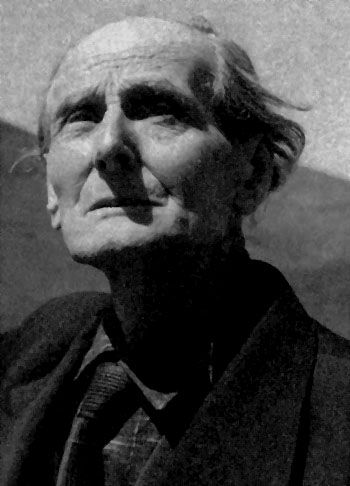 Déodat Roché
Déodat Roché
Déodat, however, never focussed on Montségur or the “initiation caves” in Ariège. He thought these were mere tourist attractions. Spiritual people today still visit these caves, claiming they feel the energy of the Cathars and they do ceremonies there. Some scratch motifs on the walls; later visitors believe these were left by the Cathars. There is no historical evidence whatsoever of Cathars hiding in the caves when on the run or of conducting “ceremonies” there. The only mention in history is the cave on the Col de Peyre where the treasure from Montségur was hidden en route for Italy.
Déodat wrote about the religious ideas of the Cathars as truly dualist. What he discovered was never scientifically defined, but seems to be some sort of echo from within himself. In short, some think he was reincarnated from one of the Cathars.
Déodat’s home town of Arques had a strong connection with Pierre Authié, one of the new wave of Parfaits in the early fourteenth century. Déodat found an image of Authié and indeed, the two looked alike.
Déodat Roché had studied esoterisicm since the age of 14 and in 1896 affiliated himself with a group run by the magician Papus, then he joined a “Gnostic” church and became the bishop of it at Carcassonne. He joined the Grand Orient, a masonic lodge. He was a friend of Prosper Estieu, a félibré or Occitan poet, who founded a magazine called simply - Mont Ségur. The two had met in June 1900 at Rennes-le-Château, where Prosper was a supply teacher; they would have been at least working colleagues with Bérenger Saunière, the priest at the time. Interest in the Cathars was now linked to the interest in the Occitan language and the medieval troubadours.
At Arques Déodat worked in local government and continued his research into Catharism. He and his society, Société du souvenir et des études cathares, placed the stèle written in Occitan at the foot of Montségur in 1961. He died in 1978, aged 101.
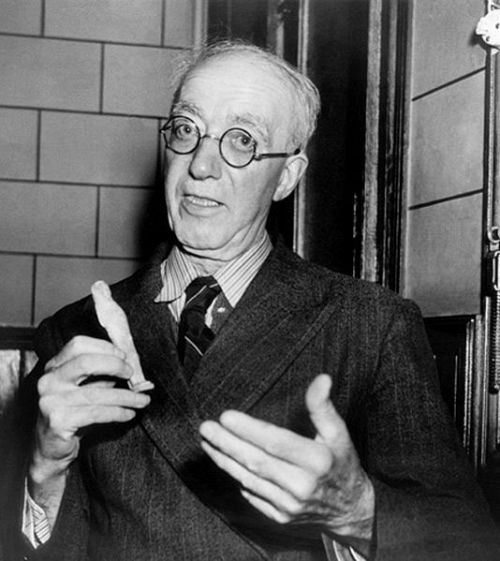 Antonin Gadal, a persuasive speaker
Antonin Gadal, a persuasive speaker
Another great name of this times was Antonin Gadal, born in Tarascon, Ariège in 1877. Gadal grew up in a house next to the Tarasconian historian Adolphe Garrigou who specialised in the history of the Cathars and, seeing a kindred spirit in the young man, took him under his wing as an inheritor of his knowledge. As an adult, Gadal worked as a schoolteacher but his fascination with the Cathars led him to the caves he believed were hiding places and sites of worship for the Cathars. Through his investigations he developed a detailed picture of what he believed were the inner mysteries of their faith.
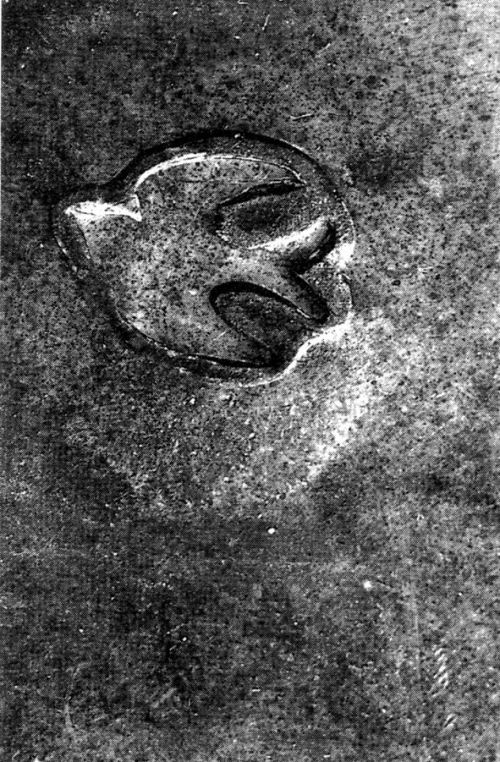
In the cave of Lombrives he discovered this dove in front of one of the caves of Ornolhac. It's a thin sheet of bronze, 40cm by 30cm, and the dove itself (that some say is a swallow) is 10cm by 10cm. It's possible it was inked and used to stamp the image of the dove.
Meanwhile, I found a copy of a book by Antonin Gadal called Montréalp de Sos, Le Château du Graal. There is no village in Ariège of this name but I put together various researches and concluded it was the château of Lordat, a little to the south of Tarascon near Ussat-les-Bains.
Gadal starts by describing the legend of Hercules in the Pyrenees; whenPyrene the beloved of Hercules died, he built a huge cairn to her and the boulders made the mountains we know today. The cave called Lombrives was Hercules’ magic cave. Since medieval times, Gadal says, the cave contained several scenes from the Grail story, painted in three colours.
He concludes that the château of “Montréalp”, the Grail castle, sheltered the Cathar faith. The Grail was the material symbol of the Christian faith, but the Cathars rejected material things. Neither did the Cathars bear arms. (They did!) Therefore the Cathars were not the guardians of the Grail - the Templars were. The Holy Grail is the blood of Christ, the divine master, it is purity, it is perfection, it is a stone from the sky . . . . maybe Gadal never knew that the saints John the Baptist and Mary Magdalene were particularly loved by the Templars.
Later Gadal links the Grail to the Manichéans, those whom the Roman church declared were the originators of Catharism. It seems at times that he is referring to the castle of Montségur, but he later tells us that Ussat is one of the “high places” where the spirit blows and has blown for thousands of years. The caves of the region have served the Magdalenien cults (by that he means from the period of that name in prehistory), the Neolithic priests, those from the Age of Iron and Bronze (the Celts) and also the Cathars.
In the 1930’s Gadal attracted a circle of adherents, including English-speaking people who came from English groups and secret societies to find the “Truth” for themselves. Gadal formed the Société du souvenir de Montségur et du Graal to promote the hidden history of Catharism, linking it to the Holy Grail. Neo-Catharism came into being. Dualism was all; good and evil, light and dark, sun and moon, male and female.
Mary Magdalene, believed to be Jesus’s wife by the original Cathars, became part of these ideas for she represented the feminine side of the divine duality of male and female. Her marriage to Jesus now became sacred. (None of these Neo-Cathars, many of whom came from a Catholic upbringing, seemed to think that Jesus was with her while she was here in France - a sore point with me!)
Many people joined Gadal in the search for spiritual treasure. One of these was the Englishman Walter Birks. After studying history at Merton College, Oxford, in the early 1930s, Walter went to lectures given by the occultist Dion Fortune and was inspired to devote his life to the supernatural. He later said: "She was a marvellous speaker and a whole new world opened up to me - or so I thought at the time. I was immensely impressed and joined an occult order."
During a seance he was given instructions from the White Eagle Lodge, a spiritualist circle, to go to the Pyrenees and recover traces of a brotherhood: "I was teaching at a school in Wales, but was instructed by the Order to resign because a great job was planned for me." Birks wrote in his diary: "I was greeted by Antonin Gadal who told me that he had been awaiting my arrival in `the year of the Grail'."
He found that Catharism claimed to be nothing less than the true Church of Christ, its orders handed down in unbroken succession from the Apostles. Furthermore, the Cathars reputedly held great treasures within their citadel base of Montsegur. During 1937 and 1938 Birks explored the castle and the surrounding caves which had become holy sites.
Gadal was an inspiring speaker and the power of his oratory coupled with his utter sincerity convinced Birks that Gadal possessed hidden spiritual truths. Birks settled in happily, assisting Gadal in his work and acting as his amanuensis. Gadal in turn enabled Birks to become manager of both the local spas and the nearby Grand Hotel des Bains. They were staying at Ussat, with its thermal baths, just to the south of Tarascon.
Gadal was by now more than 60 years old. During 1938 he came to the decision that Birks was to be his successor and, on 16 September that year, a formal ceremony took place in the nearby rock church of Ornolac in which the young Englishman was duly anointed. Gadal expected him to continue the esoteric tradition in Ariège.
Meanwhile, war in Europe was on the horizon. Returning home, Birks was commissioned into the British Security Mission in Syria. For three years he was Head of Mission in Lattakia, a particularly sensitive area close to the Turkish border. There, a friendship with a representative of the local Nosairi religion led him to rethink his spiritual views. He later wrote: "It was there, high in the Nosairi mountains, under the clear stars, that I finally shed the fantasies . . . and realised the true nature of the Cathar treasure."
In 1987 he finally published his magnum opus on the subject. It was a joint publication with the writer Robert Gilbert, entitled The Treasure of Montsegur, and opened up for the first time the “truth” about the Cathars and their secret treasure, a treasure that was more spiritual than material.
As Birks pointed out in the book, the four who escaped death by fire in 1244 had such a difficult route out of the castle they certainly could not have hauled material possessions. "All natural treasure like gold had long gone. And going down a steep hill on ropes meant that they could not have carried anything with them. If all the Cathars had been exterminated their claim would have died with them." History confirmed the Cathars had agreed that, to save their religion, the “treasure” should be spirited out by four who might succeed and live, although the rest would be executed.
Walter and Robert Gilbert also wrote a great deal about the ancient Jewish religion called Nosairi, apparently proving the roots of Catharsm were with this strangely distant and romantically described group. The important symbols were a cup from which the sacramental wine was drunk. A Nosairi priest told them that the Grail is a symbol, standing for “the doctrine which Christ taught to John the Beloved alone.”
For Walter this was the final link “which completed the chain I was trying to reconstruct from the Cathars back to Christ.” During Holy Communion wine, representing the blood of Jesus, is offered in a vessel or cup; this cup held the Divine Light. Christ was the living Grail. The Nosairi love of St. John’s Gospel explained why the Cathars also held this gospel in such great respect, Walter concluded.
He writes passionately but the Nosairis were a Christian group that had to remain secret because they were under Moslem rule. Mohammadism did not start until the 7th century and the Cathar beliefs were well established before that in Languedoc and Ariège. ( Click here to read more.)
After the war Birks returned to Ussat-les-Bains where he and Gadal attempted to revive the fortunes of the spa, but post-war austerity was biting and in 1948 the lease was surrendered. Walter then took jobs teaching in Cairo, Istanbul and Tripoli where he had time to write about Catharism.
He retired to a quiet flat in a residential quarter of Bath, lecturing in history and religion at the city's Technical College, and later became a valued tourist guide for the City Council.
Then something strange happened; by the end of his life Birks viewed the Cathars with barely disguised contempt: "There has been masses of occult nonsense written about Cathars. I believed it all those years ago but now know it is a lot of hooey. Montségur is rather like Glastonbury. It attracts all the weirdies and beardies looking for treasure. They all think they know the answer, but the occult is a lot of baloney."
Enter the Germans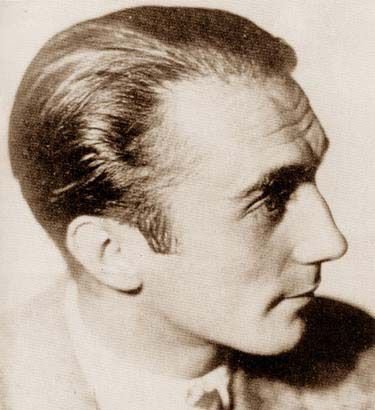 Otto Rahn
Otto Rahn
Déodat’s ideas were taken up by Maurice Magre, a talented and prolific writer who took opium and wrote two novels about the Cathars. In Paris, Maurice met and was interviewed by the German, Otto Rahn. Otto was passionate about the Holy Grail and was investigating the connections between the German Holy Grail stories, especially the medieval Parsival by Wolfram von Eschenbach, and decided that he agreed with Péladan - Eschenbach’s Grail castle, Montsalvat, was really Montségur. He set out to prove that Eschenbach’s medieval Holy Grail story was based on reality, and came to Montségur in the 1930’s, assembled all the Pyrenean Grail stories and compared them to the old German stories. He persuaded Antonin Gadal to take him on a tour of the various Cathar Cave locations. He wrote a book called The Crusade against the Grail; the brutal armies of the Pope and the King of France were not attacking an alternative religion, the Cathars - they were attacking the Holy Grail itself. Heady stuff.
Montsalvat was Montségur and the guardian of the Grail was Esclarmonde de Foix. The Grail was a sacred stone that had fallen from Heaven and she hid it in the mountains before the taking of Montségur. Her stone was later, apparently, taken to Bavaria and buried under a glacier in the Alps.
Antonin Gadal and Otto Rahn were in complete agreement over the “Cathar caves” where marvellous things were to be discovered, but Otto later claimed he had explored them alone. In a cave at Ussat he was caught drawing on the walls and thrown out by an irate historian. The cave is called the Bethlehem cave after a ray of light falling on a “natural stone altar” - a slab on the floor, now used by spiritual people for “initiations” - into what?
Otto Rahn’s Cathars were pagans and (this was new) they were troubadours. Suddenly Cathars were at the centre of all the Holy Grail stories. They were also the pure race of Nordic Germans. This was strange, as the people of Languedoc hated “the men from the north.”
However, the mysterious Countess Miriam Pujol-Murat adopted, or patronised, Otto Rahn, (she invited him to lunch, Lordat and the Mediterranean), lending him her car and chauffeur to do his research. She owned the castle of Lordat, a Cathar retreat never attacked, and Otto joined an archeological dig there organised by the Polaires, another mystic research group. They were expecting to find Cathar treasure, a Gnostic Gospel of St. John, or the grave of Christian Rosenkreutz, the founder of the Rosicrucians. But the excavations found nothing out of the ordinary although it is said that Otto’s ghost still visits Lordat.
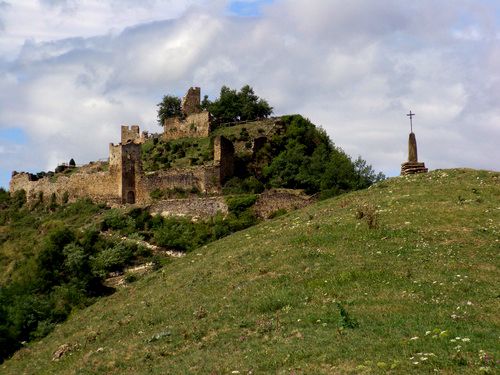
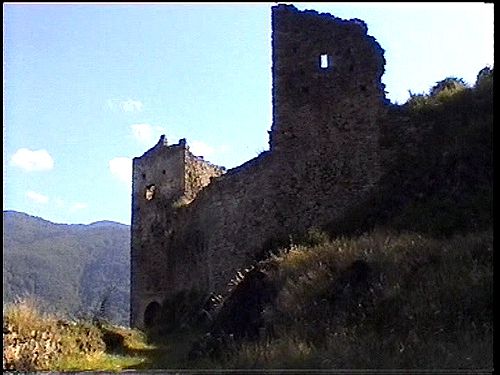
Two pictures of Lordat castle, to the south of Tarascon, Ariège.
The Countess claimed to be a descendant of, or reincarnated from, Esclarmonde de Foix, who was seen as one of the most esteemed Cathar Parfaites and held responsible for the rise of Montégur as the “Cathar Vatican.” It was more than a place of refuge, it was a cathedral, a temple - a solar temple, no less! The Countess was hoping to discover the lost treasure of the Cathars. The Countess believed this treasure was hidden at Montségur by Esclarmonde herself, who apparently then threw herself off the mountain to escape the Papal troops. The name Esclarmonde is on the Inquisition’s list of who was burnt alive that fateful day of 16th March, 1244, but it was Esclarmonde de Pereille, not Foix.
On his return to Germany, Otto was obliged to join the SS and returned to the Ariège and Montségur in 1937 to write the Court of Lucifer. (Montségur had been known as the Synagogue of Satan. Satan was once Lucifer, the angel of Light, who quarrelled with God and was banned from heaven.) When the book, the Court of Lucifer was published, it was full of flowery language but no substance, while Otto’s superiors had expected him to prove the German Parsival story, and reveal the physical Holy Grail and take it to Germany. So he was recalled and sent to work in Dachau. Some say the horrors he saw there drove him to suicide in 1939.
Meanwhile, in France the writings of Déodat and Magre led to serious archeological studies at Montségur which gave interesting insights to medieval life but never found anything Holy. The pictures of things the archeologists found, everyday things like buttons, small coins, a set of dice, a pair of scissors, are moving rather than dramatic.
And members of the White Eagle Lodge still visit Lordat every year.
In Part 3, we look at the Grail representing Mary Magdalene and the bloodline of Jesus. Click here
Inscrivez-vous au site
Soyez prévenu par email des prochaines mises à jour
Rejoignez les 261 autres membres

